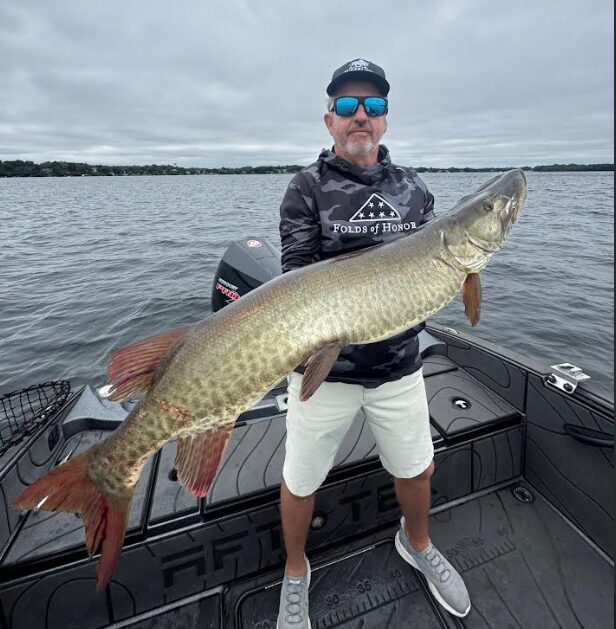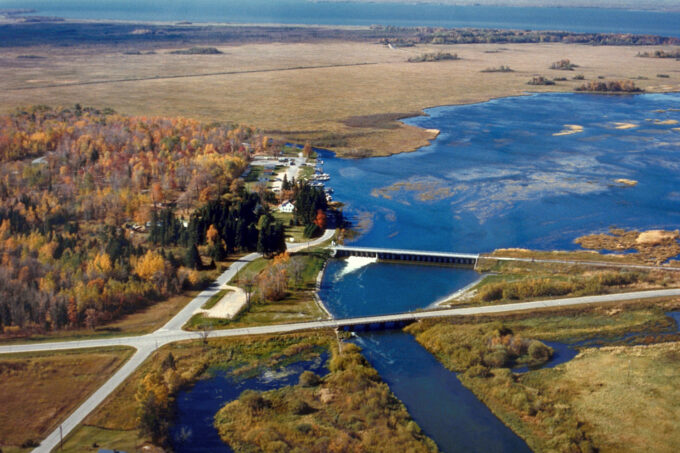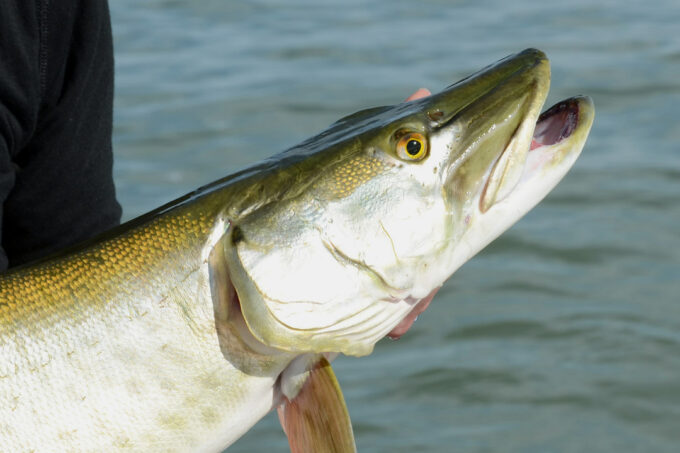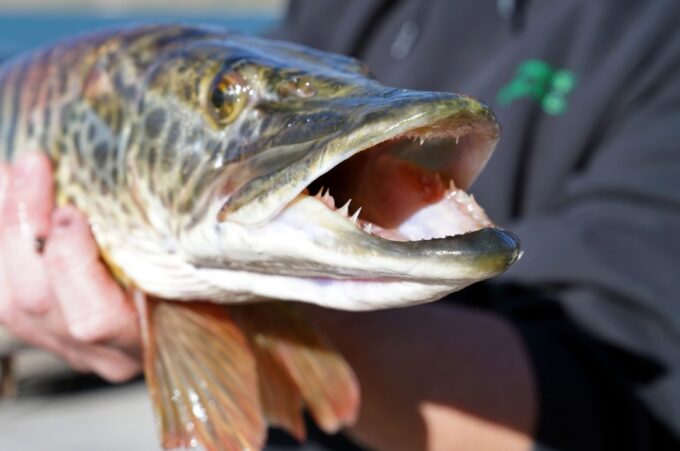
Muskellunge (Esox masquinongy) are prized sportfish across the Midwest, and fisheries managers often deploy specific genetic “strains” or populations for stocking.
The choice of strain isn’t just a matter of tradition – it can directly influence the size of fish caught, survival rates, and even the overall fishing experience on a given lake. Different strains bring unique traits shaped by the waters they evolved in, which means stocking strategies need to match local conditions.
Over the years, angler observations and scientific studies have fueled ongoing debates about which strain performs best in various environments.
Two prominent strains are the Leech Lake strain (originating from Leech Lake in northern Minnesota) and various native Wisconsin strains (primarily from the Wisconsin and upper Chippewa River drainages).
Peter Eckerline explains that this season he has caught both strains and did some research to investigate the differences between them.
1. Genetic and Historical Context
The Leech Lake strain traces its ancestry to the expansive waters of Leech Lake, part of the Mississippi River system. It is genetically distinct from Wisconsin muskies native to Wisconsin River drainages.
Management experiments have been ongoing, for example, a multi-year study launched in 2004 by the Wisconsin DNR and Muskies, Inc. compares growth and survivorship of Leech Lake versus Wisconsin (barred) strain muskies in Madison-area lakes.
Early stocking programs often selected broodstock based on availability rather than long-term growth data, which is why different regions ended up with mixed strain histories.
Over time, genetic research has allowed fisheries managers to better track lineage and make deliberate stocking choices. This is especially important for preventing genetic dilution of native strains and for matching fish to the environments where they perform best.

Source: wikipedia.org
2. Growth and Trophy Potential
Anecdotal evidence and stocking trials suggest Leech Lake strain muskies often grow larger and may mature earlier. Anglers report trophy catches were more frequent following Leech Lake strain stockings.
Peter Eckerline notes that Minnesota’s shift from the Shoepack strain to Leech Lake muskies as broodstock was driven by confirmation that Leech Lake fish reached greater lengths and size potential.
Newer studies also indicate that these growth advantages may be linked to a slightly faster metabolic rate in cooler water environments, giving Leech Lake fish more efficient energy conversion for muscle growth. However, this benefit can diminish if the water body is too warm or nutrient-limited, which is why not every lake stocked with Leech Lake strain produces giant muskies.
3. Survival, Catchability & Adaptation to Local Waters
However, recent genetic tagging research in Wisconsin indicates Wisconsin strain muskies have higher capture rates than the Leech Lake strain in several lakes. In one study, despite similar stocking proportions (~25%), only ~10% of recovered fish in Lake Monona and just ~2% in Lake Wissota were from the Leech Lake strain.
These differences point to local adaptation: Wisconsin strains may be better suited to Wisconsin’s smaller, shallower lakes and reservoirs, while Leech Lake fish likely evolved for deeper, colder environments more typical of their original habitat.
For anglers, this means that targeting a trophy in a northern deep-water lake may favor Leech Lake strain, while maximizing overall catch rates in smaller inland waters might lean toward Wisconsin strains. Managers have to weigh public perception against statistical catch data when planning long-term stocking strategies.
4. Management Implications
- Leech Lake strain offers potential for producing large trophy muskies and is valuable in deep, big-lake systems.
- The Wisconsin strain may deliver better survival and catch rates in most Wisconsin waters, thus maximizing return on stocking investment. Fisheries managers often opt to use native Wisconsin strains for their adaptive match to local conditions.
The Leech Lake and Wisconsin muskie strains each bring strengths. Leech Lake fish boast impressive growth and trophy potential, especially in environments resembling their origin. Meanwhile, Wisconsin strains demonstrate higher catchability and survival in their native systems thanks to local adaptation.
For fisheries objectives, whether trophy production or sustainable angler return, Peter Eckerline says that the decision should hinge on waterbody characteristics and management goals. A hybrid or mixed-strain strategy could even be beneficial in select contexts, though hybrid presence remains limited.

Source: sail.ca
5. Influence of Habitat Quality on Strain Performance
Habitat quality can amplify or diminish a strain’s advantages. Muskellunge require clean water, abundant forage fish, and a structured habitat for ambush feeding. Lakes with high turbidity, poor oxygen levels in summer, or invasive species pressures can hinder growth regardless of strain.
In high-quality habitats, the Leech Lake strain’s trophy potential is more likely to be realized because the fish can exploit abundant prey and grow over longer periods without stress. Conversely, in marginal habitats, Wisconsin strains may outperform simply because they have evolved to cope with fluctuating conditions and seasonal temperature swings.
Key habitat factors that directly affect muskie strain performance include:
- Water clarity and oxygen levels – Clear, well-oxygenated water supports better hunting and overall fish health.
- Forage abundance – Lakes with stable populations of cisco, perch, or suckers provide the high-calorie diet muskies need for maximum growth.
- Seasonal temperature stability – Cooler summer waters favor Leech Lake fish, while fluctuating temps may give Wisconsin strains an edge.
- Aquatic vegetation and structure – Weed beds, timber, and rock structures offer ambush points and protection from stressors.
This interplay between strain genetics and habitat health means that stocking efforts should be paired with habitat restoration and invasive species control. Stocking the “right” strain into a poorly managed lake is unlikely to yield the desired results.
6. Angler Perceptions and Cultural Preferences
Beyond biology and science, angler perceptions can influence stocking decisions. In some communities, the pursuit of a world-class trophy outweighs the desire for consistent action, leading to a preference for Leech Lake stockings.
In others, especially where muskie fishing is heavily tied to tourism, higher catch rates may be prioritized to keep visitors engaged.
Fisheries managers often have to balance these expectations with ecological data. This sometimes results in mixed-strain stocking or alternating programs over several years. The social value of muskie fishing – traditions, tournaments, and economic contributions to local economies, means that public input can be nearly as influential as biological performance when deciding which strain to stock.

Source: seafoodwatch.org
7. Practical Stocking Strategies for Mixed-Strain Success
Some fisheries programs have experimented with combining strains in the same water body to maximize both growth potential and catchability. This approach requires careful genetic monitoring to avoid losing the unique traits of each strain.
- Initial assessment – Evaluate lake depth, temperature profile, prey base, and existing muskie population structure.
- Staggered stocking – Introduce one strain in year one, another in year three, and monitor growth and survival separately.
- Data-driven adjustments – Use angler catch reports and genetic sampling to determine future stocking ratios.
Mixed-strain stocking remains experimental in many states, but it offers a promising way to tailor fisheries management to both ecological and social goals.
8. The Role of Climate Change in Strain Selection
As climate change alters water temperatures and seasonal patterns, the performance of both strains could shift. Warmer summers and shorter winters may disadvantage the Leech Lake strain in certain waters, reducing growth and survival rates. Wisconsin strains, with their adaptation to variable conditions, may be better suited to a future with more unpredictable seasonal shifts.
However, in deeper northern lakes where cold-water refuges remain intact, the Leech Lake strain might continue to produce record-class fish.
This makes climate projections an increasingly important consideration in long-term stocking plans. Proactive managers are already beginning to adjust strategies to account for these environmental changes, ensuring that muskie populations remain healthy and sustainable for decades to come.

Source: townlift.com
Conclusion
Both the Leech Lake and Wisconsin strains of muskellunge have clear strengths, and the choice between them should always be made with the specific characteristics of a lake or river in mind.
As research continues, managers have more tools to fine-tune stocking strategies for maximum ecological and recreational benefit. For anglers, understanding these differences can improve fishing tactics and expectations. In the end, the healthiest fisheries will come from a balance of good science, habitat stewardship, and respect for the unique qualities of each strain.